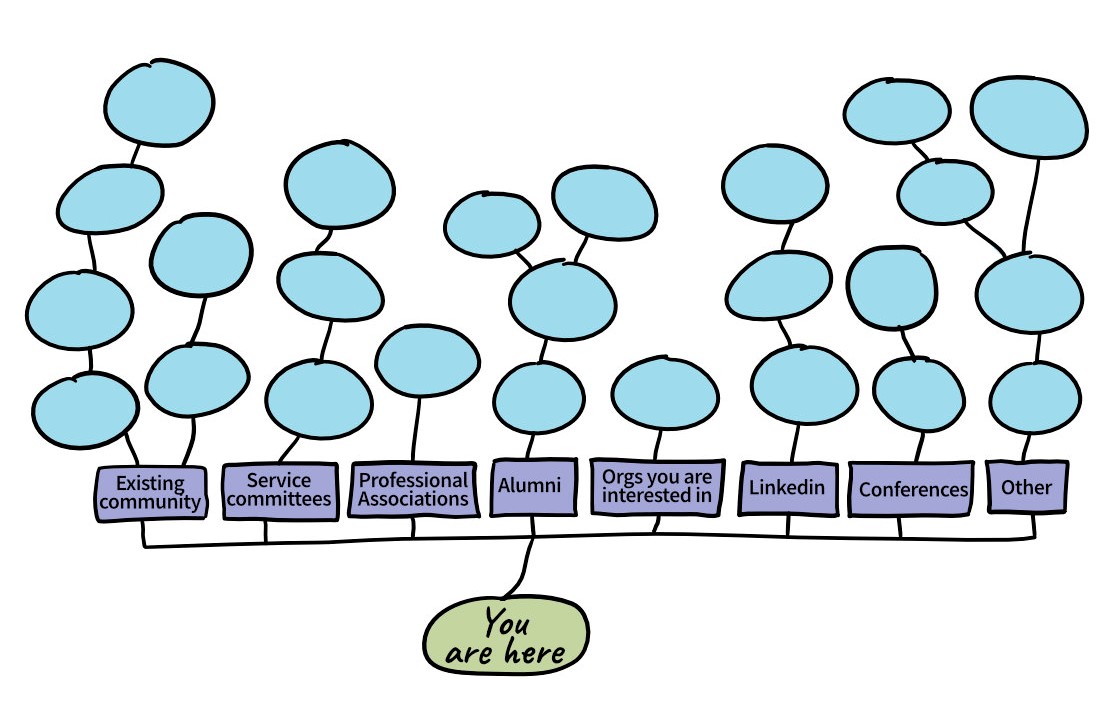Activity: Connecting With Community Mind Map
Activity: Connecting With Community Mind Map
Who comes to mind that you’d like to get to know better?
We suggest choosing people you know to connect with first because in the beginning this can be easier and/or less intimidating. More scientifically there is the notion of multiplex ties, which supports reaching out to people you know. In an interview, Monica Mullick Stallings states from her research on network preferences that:
“we have a measured preference for connecting with people with whom we have multiplex ties, or ties that involve an overlap of roles, or affiliations in a social relationship.” We are much more likely to network with those whom we also interact socially, for instance, because our children go to the same school, or because we occasionally train jointly for marathons, than if we simply work together. When we know a person in multiple contexts, there’s greater depth and richness to the relationship, and embedded within that, a higher degree of trust (Johnson, 2011).
Keep in mind, we often gravitate to people like us because people who are typically like us validate our opinions. "Be open" (stated in the video Want to Network Better? Follow These 5 Tips From Master Connectors (Downes, 2019) in the Unit Introduction.) When you stretch and connect with those beyond your interests, your industry, or home country you learn about other perspectives, and broaden your mindset and your community!
 Start
to capture the names of people that come to mind, use the downloadable Mind Map, type a list in a Google doc, or use pen and paper to draw out your mind map, whatever is easiest for you.
Start
to capture the names of people that come to mind, use the downloadable Mind Map, type a list in a Google doc, or use pen and paper to draw out your mind map, whatever is easiest for you.
![]() Download the Connecting With Community Mind Map
Download the Connecting With Community Mind Map
We’ve filled in the first level on the Mind Map with ideas to prompt you: beginning with your existing community in your immediate personal circles, then moving into your professional connections: service committees, professional associations, etc. Fill in the fields with their names, as other people come to mind, add their names in the next set of fields and so on.
For all Royal Roads alumni, connect with the LinkedIn Royal Roads page and explore the Alumni tab, it is an invaluable resource!
You can also use your LinkedIn account, and search for people who are “Willing to help.” You can narrow your search based on geographical region, work experience, or alumni who have graduated from your program. Once you login, draft a message introducing yourself and click send. It is that simple and accessible! In addition, there are a number of resources at your fingertips: events, job board, and a business directory. It’s a great way to connect!
Next, you can add people who you don’t know directly such as influencers in your field or someone you met at a conference who is doing work that interests you. These are secondary connections: people in your primary group may know and could offer an introduction.
Here are further ideas: parent-teacher groups, faith-based or spirituality circles, professional associations, alumni, your professors, mentors, clubs like Royal Roads Proud or the Diversity Action Group, classmates, and former employers.
You can research people who work at organizations and professional associations in industries you are considering or in positions that interest you.
Think of your 1st, 2nd, and 3rd degree connections in LinkedIn and other social media platforms.
There may be some concern about finding the time to meet with and follow up with 10 people. Generally speaking, it is rare that all 10 people will have the capacity to connect and/or respond at the same time.
Once you have generated a list of 10 people, to maintain the momentum and stay motivated, we invite you to design a 26-WEEK Challenge. You can transfer the names from your list to the 26-WEEK Challenge Worksheet to keep track of who you’ve contacted, how, and when. Move on to the next activity, Connecting With Community 26-Week Challenge to get started.